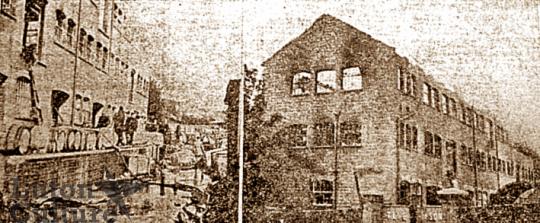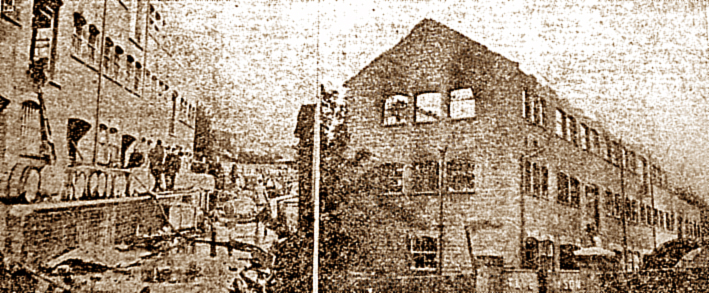Huge blaze at Lye dye works

Luton had witnessed some spectacularly destructive fires unrelated to the conflict during World War One. They included a blaze at the Diamond Foundry in Dallow Road in September 1916, at the Brown & Green Foundry in Windsor Street/South Road in November 1915, and at the Wing, Arnold & Wing hat factory two days later. On Sunday, September 15th, 1918, a blaze at the T. Lye & Sons dye works in Old Bedford Road lit up the night sky. This was how The Luton News reported the Lye blaze.
It is almost impossible that Luton could have witnessed a more brilliant night scene than that to which we were awakened in the small hours of Sunday. The moon, just arrived at its first quarter, was blotted out by thick clouds which were diminishing themselves by process of steady drizzle, the night was pitch dark, and to those people who were unfortunate enough to be on nocturnal duty, it was a dismal and depressing experience.
With remarkable speed all this changed. It began with a glimmer to the north of the town, and then grew brighter and brighter until one could discern chimney stacks, houses and trees, and those resident on the high hills surrounding the town beheld the streets and the prominent buildings in the basin illuminated as they have not been these three years, and, as the light in the north irradiated, the whole town could be seen nestling snugly beneath the wooded and verdant hills, the wet roofs shining and reflecting the brilliance.
From the very heart of the valley suddenly sprang two challenging lights, heading northwards. They were the eyes of the fire engine proceeding to the scene of the fire – the branch premises of Thomas Lye & Sons, Old Bedford Road. The fire was well ahead when the Fire Brigade received the call, and when the brass-helmeted men arrived great tongues of flame were were already shooting through the roof, dense clouds of pungent smoke were issuing, occasionally relieved by vivid showers of sparks and burning cinders as some massive girder, beam or strut fell with a crash from floor to floor.
There were already a number of people, those of the immediate vicinity, on the spot, and workmen from the principal establishment of the firm, on the opposite side of the street, were at work with a couple of hose pipes endeavouring to reach the flames. Unfortunately they were hopelessly handicapped by the fact that the stream was no stronger than that of a parish pump. Something was wrong with the connections, and before they could do anything effective, the whole building was ablaze from end to end.
To the crackle and roar of the flames there eventually came intermittent booms as barrels of chemicals exploded, and heavy machines came hurtling from the top storey into the debris, and these roused the town. There was a shouting from bedroom windows, a scurrying of feet along the paves, and from all parts of the town and district hurried people in more or less dishevelled attire, rubbing the sleep from their eyes, but grateful to realise that their first fears of an air raid were groundless.
It was at 1.30am when the fire was discovered, the night watchman at the New Bedford Road premises having noticed the reflection of the flames from the windows of the two houses opposite. He and some colleagues got to work with the private hose pipes.
The Borough Fire Brigade received the call at 2.05am, the notification being that there was a fire in Clarendon Road. This error – undoubtedly a genuine mistake on the part of the gentleman who telephoned – was the reason only one engine was brought at the outset, but the second was at once summoned and soon arrived and got to work. No 1 engine was stationed in New Bedford Road and No 2 in Clarendon Road.
It was really when the increased volume of water was brought into play that the explosions increased. They came from large casks, and sometimes there was a pause of two or three minutes between, at others they seemed to burst with the regularity of a machine gun or extraordinary calibre.
By this time there were some thousands of people in attendance and the whole of the police force on night duty, along with many Special Constables, were present. Inspector Janes, who had gone off duty a few minutes before the alarm, returned and took charge, but there was no trouble with the crowd.
A busy whisper circling around reported that there were 200 tons of brimstone in the building, and the sightseers, including many ladies who had hastily dressed and had not taken the trouble to remove their curl papers and other cunning contrivances for the hair, showed a less curious disposition than usual in consequence of the rumour, and were content to keep well away from the gates.
Certainly a good deal of colour was lent to this report when their came a blast like the bursting of a heavy bomb. A sheet of flame and white smoke leaped skyward, and a gable part of the wall, several windows, and the remainder of the roof fell with a thunderous crash. As the mass of masonry fell, two firemen sprang aside only just in the nick of time.
This was at 2.40, and the fire had been under weigh just about an hour. So it continued for three hours, and the spectators gathered some little idea of the terror of liquid fire, for patches of multi-coloured flame shot up at intervals and lingered for many seconds before they disappeared, while the periodic explosions sent showers of the white ash of charred plait high in the air, and the fragments mingling with the rain gave the appearance of thin sleet.
As the flames were reduced from white to red heat and were brought very low, the pungency of the fumes increased, for the heavy pressure jets of water broke up a solid mass of sulphur and raised huge clouds of the suffocating vapour.
Providentially, there was very little breeze, and the sparks and the fumes rose in almost perpendicular columns to the heavens, otherwise the interested spectators would have required no persuasion to depart, while the residents in the vicinity would have had an uncomfortable surprise.
Two ladies from houses directly opposite the fire were brought out of harm's way as a precautionary measure, but from 3am it was apparent that the fire and its effect had been restricted to the enclosed premises.
It was nine o'clock before Chief Officer Andrew deemed it prudent to send the engines home, and even then several jets were working at full pressure on the smouldering ruins.
Throughout Sunday smoke oozed and issued, and just before noon the brigadiers had to demolish the eaves and the gutters before the water could fully penetrate to the heart of the fire. A strong stream of polluted water, varying through colour stages from orange to black, poured out of he yard down the Old Bedford Road all day.
There was a steady pilgrimage of people from the town and district to the scene until the moon was high on Sunday night, but they were mostly orderly. They saw the mere shell of a building some 50 yards in length and about 40 feet height by 20 feet wide, bent and twisted girders, charred timbers and misty lines of smoke. The more picturesque scene was witnessed in the dead of night.
A three-storey building, its contents were extremely valuable. The third storey accommodated some £3,000 worth of machinery, the engineering shop. The first floor, in addition to chemicals, had a considerable amount of plait. The ground floor was occupied with stores of dyes, chemicals, sulphur to the extent of nearly 100 tons, and other materials for the bleaching and dyeing industry.
The whole of the Fire Brigade tuned up and worked like Trojans. The situation was fraught with a good deal of peril, both by reason of the restricted area in which they had to operate and the nature of the contents of the building. In spite of the continuous exertion for 11 hours at a fire on the Luton Hoo Estate during Friday night, they mustered very promptly and threw their whole energies into the work.
Mr Ernest Lye was away from home, spending his honeymoon, as a matter of fact, at Eastbourne. He returned on Monday and told a Luton News representative that the damage was largely covered by insurance, but some of the stock which perished in the flames was quite irreplaceable. His rough estimate of the damage was between £50,000 and £60,000.
[The Luton News: Thursday, September 19th, 1918.]
Event Place
Author: Deejaya



Add comment